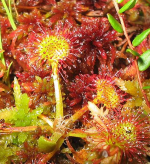
Carnivorous
plants like the pitcher plant, Venus flytrap, and sundew have evolved
to get necessary nutrients from the bugs they eat, usually because the
soil in their environments don’t have enough of them. But a new study
shows that at least one kind of carnivorous plant, the common sundew (
Drosera rotundifolia) will stop doing so when there is more nitrogen than usual in their soil, such as when nitrogen-rich acid rain falls.
A study published in New Phytologist shows that this
artificial rain of fertilizer is now making carnivorous plants lose
interest in insect prey. Plants in lightly-polluted areas got 57 per
cent of their nitrogen from insects; in areas that receive more nitrogen
deposition, that figure fell as low as 22 per cent.
“If there’s plenty of nitrogen available to their roots, they don’t
need to eat as much,” explains Dr. Jonathan Millett from Loughborough
University, the report’s lead author. Instead, they rely more on
nitrogen absorbed through their roots.
How did the plants manage this rapid shift in diet? Millett says
earlier experiments have suggested they can make their leaves less
sticky, trapping fewer prey. He adds that a color change may also
contribute; sundew plants in highly polluted bogs are much greener than
those growing in nutrient-poor conditions. The latter typically have a
red color that’s believed to attract insects. He even suggests that
looking at the color of sundew plants could give ecologists a quick way
to gauge how much nitrogen pollution an area has suffered.
That may be handy for us, but it may spell trouble for the species,
which spent a lot of time evolving its specialized niche, and may not be
so successful adapting to rapidly changing conditions.
 Carnivorous
plants like the pitcher plant, Venus flytrap, and sundew have evolved
to get necessary nutrients from the bugs they eat, usually because the
soil in their environments don’t have enough of them. But a new study
shows that at least one kind of carnivorous plant, the common sundew (Drosera rotundifolia) will stop doing so when there is more nitrogen than usual in their soil, such as when nitrogen-rich acid rain falls.
Carnivorous
plants like the pitcher plant, Venus flytrap, and sundew have evolved
to get necessary nutrients from the bugs they eat, usually because the
soil in their environments don’t have enough of them. But a new study
shows that at least one kind of carnivorous plant, the common sundew (Drosera rotundifolia) will stop doing so when there is more nitrogen than usual in their soil, such as when nitrogen-rich acid rain falls.
No comments:
Post a Comment